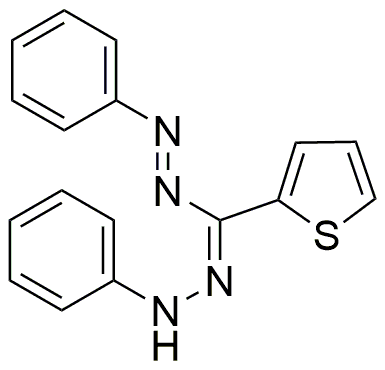1,5-Diphenyl-3-(2-thienyl)formazan is widely utilized in research focused on:
- Analytical Chemistry: This compound serves as a colorimetric reagent for the detection of metal ions, providing a simple and effective method for quantifying trace elements in various samples.
- Organic Synthesis: It acts as a versatile intermediate in the synthesis of other organic compounds, facilitating the development of new materials and pharmaceuticals.
- Biological Research: The compound has shown potential in studying biological processes due to its ability to interact with specific biomolecules, making it useful in drug discovery and development.
- Photovoltaic Applications: Its unique electronic properties make it suitable for use in organic solar cells, contributing to advancements in renewable energy technologies.
- Colorimetric Sensors: The compound can be incorporated into sensor devices for environmental monitoring, allowing for the detection of pollutants and enhancing safety in industrial settings.
Informations générales
Propriétés
Sécurité et réglementation
Applications
1,5-Diphenyl-3-(2-thienyl)formazan is widely utilized in research focused on:
- Analytical Chemistry: This compound serves as a colorimetric reagent for the detection of metal ions, providing a simple and effective method for quantifying trace elements in various samples.
- Organic Synthesis: It acts as a versatile intermediate in the synthesis of other organic compounds, facilitating the development of new materials and pharmaceuticals.
- Biological Research: The compound has shown potential in studying biological processes due to its ability to interact with specific biomolecules, making it useful in drug discovery and development.
- Photovoltaic Applications: Its unique electronic properties make it suitable for use in organic solar cells, contributing to advancements in renewable energy technologies.
- Colorimetric Sensors: The compound can be incorporated into sensor devices for environmental monitoring, allowing for the detection of pollutants and enhancing safety in industrial settings.
Documents
Fiches de données de sécurité (FDS)
La FDS fournit des informations de sécurité complètes sur la manipulation, le stockage et l’élimination du produit.
Spécifications du produit (PS)
Le PS fournit une description complète des propriétés du produit, notamment sa composition chimique, son état physique, sa pureté et les exigences de stockage. Il détaille également les plages de qualité acceptables et les applications prévues du produit.
Certificats d'analyse (COA)
Recherchez des certificats d'analyse (COA) en saisissant le numéro de lot du produit. Les numéros de lot et de lot se trouvent sur l'étiquette d'un produit, après les mots « Lot » ou « Lot de fabrication ».
Numéro de catalogue
Numéro de lot/série
Certificats d'origine (COO)
Ce certificat d'exploitation confirme le pays dans lequel le produit a été fabriqué, et détaille également les matériaux et composants utilisés et s'il est issu de sources naturelles, synthétiques ou autres sources spécifiques. Ce certificat peut être requis pour les douanes, le commerce et la conformité réglementaire.
Numéro de catalogue
Numéro de lot/série
Fiches de données de sécurité (FDS)
La FDS fournit des informations de sécurité complètes sur la manipulation, le stockage et l’élimination du produit.
DownloadSpécifications du produit (PS)
Le PS fournit une description complète des propriétés du produit, notamment sa composition chimique, son état physique, sa pureté et les exigences de stockage. Il détaille également les plages de qualité acceptables et les applications prévues du produit.
DownloadCertificats d'analyse (COA)
Recherchez des certificats d'analyse (COA) en saisissant le numéro de lot du produit. Les numéros de lot et de lot se trouvent sur l'étiquette d'un produit, après les mots « Lot » ou « Lot de fabrication ».
Numéro de catalogue
Numéro de lot/série
Certificats d'origine (COO)
Ce certificat d'exploitation confirme le pays dans lequel le produit a été fabriqué, et détaille également les matériaux et composants utilisés et s'il est issu de sources naturelles, synthétiques ou autres sources spécifiques. Ce certificat peut être requis pour les douanes, le commerce et la conformité réglementaire.


